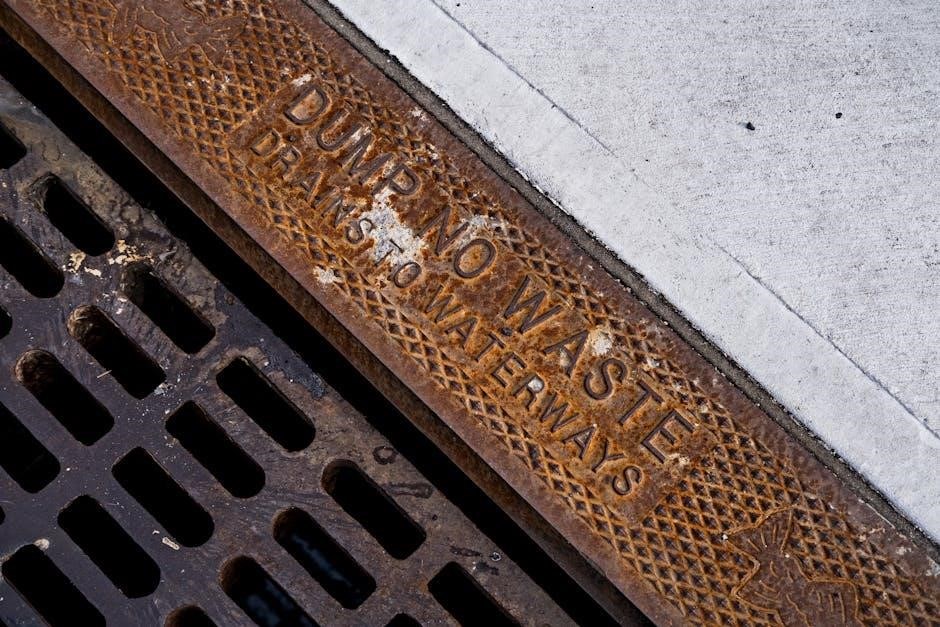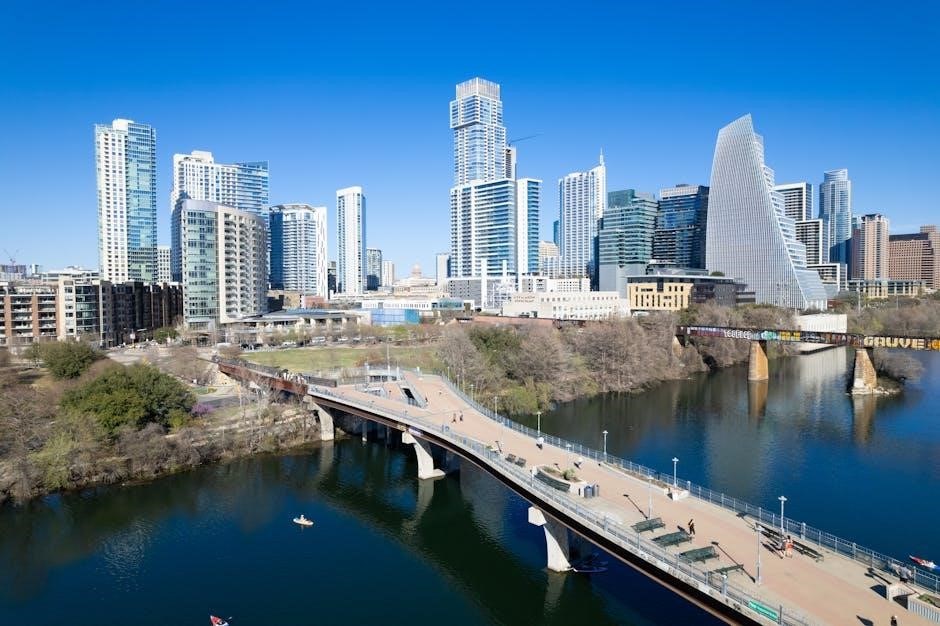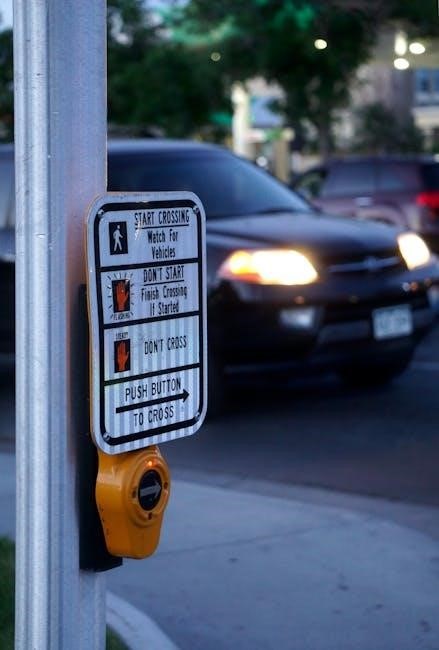The City of Austin Drainage Criteria Manual provides standardized principles and practices for designing and constructing drainage systems, ensuring public safety and environmental protection through effective stormwater management.
1.1 Overview of the Manual’s Purpose and Scope
The City of Austin Drainage Criteria Manual serves as a comprehensive guide for designing, constructing, and maintaining drainage systems within the city. Its primary purpose is to ensure that drainage infrastructure aligns with public safety, environmental protection, and sustainable urban development goals. The manual provides standardized principles and practices to guide engineers, developers, and city officials in creating efficient and resilient drainage systems.
The scope of the manual encompasses design criteria, construction standards, and maintenance protocols for public and private drainage systems. It covers components such as storm drains, open channels, and headwalls, while addressing compliance with local regulations and environmental policies. By establishing clear guidelines, the manual aims to promote consistency and accountability in drainage system development across the city.
1.2 Historical Context and Development of the Manual

The City of Austin Drainage Criteria Manual was established to address the growing need for standardized drainage practices in response to urban expansion and environmental concerns. Initially developed to align with local regulations and sustainability goals, the manual has evolved over time to incorporate advancements in stormwater management and green infrastructure. Its creation involved collaboration between city officials, engineers, and environmental experts to ensure comprehensive coverage of drainage system design, construction, and maintenance. Codified through Rule No. 161-24.10 in September 2024, the manual reflects a commitment to protecting public health and ecological balance. It serves as a foundational resource for promoting consistency and innovation in drainage system development across Austin.

Regulatory Framework and Compliance
The City of Austin Drainage Criteria Manual aligns with local zoning laws, permitting processes, and environmental standards to ensure lawful and sustainable drainage system implementation.
2.1 Zoning Ordinances and Land Use Regulations
Zoning ordinances in Austin play a crucial role in shaping land use practices, ensuring that drainage systems align with urban development goals. These regulations dictate setbacks, building heights, and landscaping requirements to maintain environmental balance. By integrating drainage criteria with zoning laws, the city ensures that new developments adhere to sustainable practices, minimizing flood risks and preserving natural waterways. The ordinances also promote the use of green infrastructure, such as rain gardens and permeable pavements, to enhance stormwater management. Compliance with these regulations is essential for obtaining permits, as they safeguard both public safety and ecological health. This integrated approach reflects Austin’s commitment to balancing growth with environmental stewardship.
2.2 Permitting Requirements and Review Processes
The City of Austin Drainage Criteria Manual outlines specific permitting requirements to ensure compliance with drainage standards and environmental regulations. Developers must submit detailed plans for review, including drainage designs, hydrologic analyses, and erosion control measures. The review process involves multiple stakeholders, such as city engineers and environmental agencies, to verify that proposed systems meet safety and sustainability criteria. Permits are issued only after thorough inspection and approval, ensuring adherence to the manual’s guidelines. This rigorous process helps mitigate flood risks and protects water quality. Additionally, post-construction inspections are conducted to verify compliance and monitor long-term performance, ensuring that drainage systems function as intended and align with the city’s environmental goals.

Design Criteria for Drainage Systems
The manual establishes design standards for public streets, emphasizing stormwater management, green infrastructure, and sustainable practices to ensure efficient drainage and environmental protection in Austin.
3.1 Stormwater Management Principles
The City of Austin Drainage Criteria Manual emphasizes stormwater management principles to reduce runoff, mitigate flooding, and protect water quality. Key strategies include detention ponds, bioswales, and permeable pavements to capture and filter rainwater. Design guidelines ensure systems can handle rainfall intensity and drainage capacity, prioritizing environmental sustainability and public safety. Regular inspections and maintenance are required to maintain system efficiency. These principles align with local ordinances and environmental goals, ensuring Austin’s drainage infrastructure supports urban growth while preserving natural water cycles and ecosystems. By integrating green infrastructure, the manual promotes a balanced approach to stormwater management, benefiting both residents and the environment.
3.2 Design Standards for Public Streets and Infrastructure
The City of Austin Drainage Criteria Manual outlines specific design standards for public streets and infrastructure to ensure safe and efficient drainage systems. These standards address runoff collection, transport, and disposal, considering factors like rainfall intensity, topography, and land use. Design criteria include minimum pipe sizes, slope requirements, and material specifications to handle peak flows while minimizing erosion. The manual also incorporates green infrastructure elements, such as bioswales and permeable pavements, to enhance stormwater management. Compliance with these standards ensures that public streets and infrastructure can withstand urban growth and extreme weather events, maintaining public safety and environmental integrity. Regular updates to the standards reflect advancements in engineering and sustainability practices.
3.3 Green Infrastructure and Sustainable Practices
The City of Austin Drainage Criteria Manual emphasizes green infrastructure as a key component of sustainable drainage systems. It promotes practices like permeable pavements, green roofs, and bioswales to manage stormwater at its source, reducing runoff and improving water quality. The manual provides detailed design guidelines and maintenance requirements to ensure these practices are implemented effectively. Additionally, it offers incentives for developers and property owners who incorporate green infrastructure into their projects. Compliance with these standards supports environmental health and aligns with the city’s broader sustainability goals, fostering a balance between urban development and ecological preservation.

Environmental Considerations and Impact
The City of Austin Drainage Criteria Manual addresses environmental considerations by protecting natural water bodies, managing stormwater, and ensuring water quality through regulated practices and standards under Rule No. 161-24.10, enacted September 6, 2024.
4.1 Erosion Control Measures and Best Practices
Erosion control is a critical component of the City of Austin Drainage Criteria Manual, ensuring the stability and longevity of drainage infrastructure. The manual emphasizes the use of techniques such as riprap, geotextiles, and vegetative stabilization to prevent soil erosion in channels and around drainage structures. Best practices include designing systems to minimize runoff velocity, using energy dissipation devices, and maintaining vegetative cover in sensitive areas. Regular inspections and maintenance are required to address potential erosion hotspots before they escalate. These measures not only protect infrastructure but also safeguard water quality by reducing sedimentation in waterways. The manual aligns with environmental regulations, promoting sustainable drainage solutions that balance development needs with ecological preservation.
4.2 Water Quality Protection and Management
The City of Austin Drainage Criteria Manual places a strong emphasis on water quality protection, aiming to minimize the discharge of pollutants into waterways. The manual outlines strategies to manage stormwater runoff, including the use of best management practices (BMPs) such as detention ponds, filtration systems, and green infrastructure. These measures help reduce sediment, nutrients, and other contaminants from entering aquatic ecosystems. Regular monitoring and testing are required to ensure compliance with water quality standards. The manual also promotes public education and outreach to raise awareness about the importance of protecting water resources. By integrating advanced technologies and sustainable practices, Austin ensures its drainage systems support both environmental health and community well-being, aligning with broader environmental goals and regulations. This approach fosters a balance between urban development and ecological preservation.

Implementation and Enforcement
The manual outlines regulatory processes for submitting, reviewing, and deciding on permit applications, ensuring consistency and efficiency in drainage system compliance and enforcement actions.
5.1 Inspection and Monitoring Processes
The City of Austin employs rigorous inspection and monitoring processes to ensure compliance with drainage criteria. Regular site inspections are conducted by city departments to verify adherence to approved plans and permits. These inspections focus on stormwater management systems, detention ponds, and erosion control measures. Monitoring activities include periodic assessments of drainage infrastructure to identify maintenance needs and prevent potential failures. The manual outlines specific protocols for documenting and addressing deficiencies, ensuring timely corrective actions. Advanced technologies, such as remote sensors and GIS mapping, are utilized to enhance monitoring efficiency. Public reporting mechanisms allow transparency in inspection outcomes, fostering accountability and community trust in drainage system management. These processes are integral to maintaining public safety and environmental integrity.
5.2 Enforcement Mechanisms and Penalty Systems
The City of Austin enforces drainage criteria through a structured system of mechanisms and penalties to ensure compliance. Violations of the manual’s standards may result in fines, project delays, or mandatory corrective actions. Enforcement begins with warnings for non-compliance, followed by escalating penalties for unresolved issues. The city employs a tiered penalty system, with fines increasing for repeated or severe violations. Additionally, permits can be revoked for non-compliance, halting construction or operation until adherence is achieved. Revenue generated from penalties funds local environmental initiatives, emphasizing the importance of compliance. Public records of enforcement actions are maintained for transparency, ensuring accountability. These measures safeguard public health, environmental quality, and infrastructure integrity. Compliance is thus prioritized to avoid legal and financial consequences. Strict enforcement ensures the city’s drainage systems meet established standards.

Maintenance and Upkeep of Drainage Systems
Regular maintenance ensures Austin’s drainage systems function efficiently, preventing clogs and erosion. Scheduled inspections and proactive repairs are crucial for long-term system reliability and effectiveness.
6.1 Scheduled Maintenance and Inspection Schedules
The City of Austin Drainage Criteria Manual outlines a detailed schedule for maintaining drainage systems, ensuring they remain functional and efficient. Regular inspections are conducted to identify potential issues before they escalate, with a focus on high-risk areas prone to heavy rainfall or urban runoff. Maintenance activities include cleaning storm drains, clearing debris from open channels, and repairing damaged infrastructure. The manual emphasizes the importance of adhering to these schedules to prevent flooding and erosion. Additionally, the city employs advanced monitoring tools to track system performance and adjust maintenance plans as needed. By prioritizing proactive upkeep, Austin aims to safeguard public safety and environmental health while promoting sustainable urban growth.
6.2 Best Practices for System Upkeep
The City of Austin Drainage Criteria Manual emphasizes best practices for drainage system upkeep to ensure long-term functionality and sustainability. Regular cleaning of storm drains and catch basins is essential to prevent clogging and maintain water flow. Vegetation management in drainage areas is critical to avoid blockages and erosion. The manual recommends incorporating green infrastructure, such as permeable pavements and bioswales, to enhance stormwater absorption and reduce runoff. Community engagement and education are also highlighted as key components, encouraging residents to report maintenance needs and avoid illegal dumping. By adopting proactive and eco-friendly strategies, the city aims to protect water quality, mitigate flooding risks, and promote a resilient urban environment.

Case Studies and Success Stories
The manual highlights successful drainage projects in Austin, showcasing how its guidelines have improved stormwater management and protected the city’s water health through innovative solutions.

7.1 Examples of Effective Drainage Projects in Austin
The City of Austin has implemented several successful drainage projects, such as the restoration of Barton Creek and the introduction of green infrastructure in urban areas. These projects have significantly improved stormwater management, reducing flooding and enhancing water quality. By incorporating sustainable practices, Austin has set a benchmark for effective drainage solutions that balance urban development with environmental preservation. These examples demonstrate the practical application of the Drainage Criteria Manual, showcasing how its guidelines have been instrumental in achieving these positive outcomes for the community and the environment.
7.2 Lessons Learned and Adaptations Over Time
Over the years, the City of Austin has refined its drainage strategies through lessons learned from past challenges. The Drainage Criteria Manual has evolved to address climate change impacts, incorporating updated design standards and green infrastructure practices. Adaptations include stricter erosion control measures and advanced water quality protections. The city has also embraced emerging technologies, such as smart stormwater management systems, to improve efficiency. Public feedback has played a crucial role in shaping these adaptations, ensuring the manual remains responsive to community needs. These changes reflect Austin’s commitment to sustainable and resilient drainage solutions, balancing urban growth with environmental stewardship. Continuous improvement ensures the manual remains a vital resource for future challenges.

Future Directions and Innovations
The City of Austin is exploring innovative drainage solutions, including smart stormwater systems and advanced green infrastructure, to enhance sustainability and adapt to urban growth and climate change.
8.1 Emerging Technologies in Drainage Systems
Emerging technologies are revolutionizing drainage systems in Austin, with innovations like smart sensors, IoT-enabled monitoring, and AI-driven predictive maintenance. These tools enhance real-time data collection and analysis, enabling proactive management of stormwater runoff. Advanced green infrastructure solutions, such as permeable pavements and biofiltration systems, are being integrated to improve water quality and reduce urban flooding. Additionally, the city is exploring modular drainage components and bioretention practices to adapt to growing urban demands. These technologies not only improve efficiency but also align with sustainability goals, ensuring the drainage system remains resilient to climate change and population growth. By embracing these advancements, Austin aims to set a benchmark for modern, eco-friendly urban drainage systems.
8.2 Adaptation to Climate Change and Urban Growth
The City of Austin is actively addressing the challenges posed by climate change and rapid urbanization through adaptive measures in its drainage systems. Rising temperatures and intense rainfall events necessitate resilient infrastructure designs. The Drainage Criteria Manual incorporates strategies to mitigate flood risks and ensure water quality, aligning with broader climate adaptation goals. Urban growth is managed through updated land-use regulations and innovative stormwater management practices. The manual emphasizes the integration of green infrastructure and sustainable designs to accommodate expanding populations while protecting natural resources. By incorporating forward-thinking policies, Austin aims to balance development with environmental stewardship, ensuring its drainage systems remain effective and sustainable for future generations.
The City of Austin Drainage Criteria Manual stands as a comprehensive guide, ensuring effective stormwater management and sustainable urban development. By addressing historical, regulatory, and environmental aspects, it provides a framework for resilient infrastructure. The manual’s emphasis on innovation and adaptation prepares Austin for future challenges, balancing growth with ecological preservation. Through rigorous implementation and maintenance protocols, it safeguards public health and safety, setting a benchmark for other cities. This document is a testament to Austin’s commitment to environmental stewardship and sustainable practices, offering a unified approach to drainage system design and management for the benefit of its community and future generations.


0 Comments